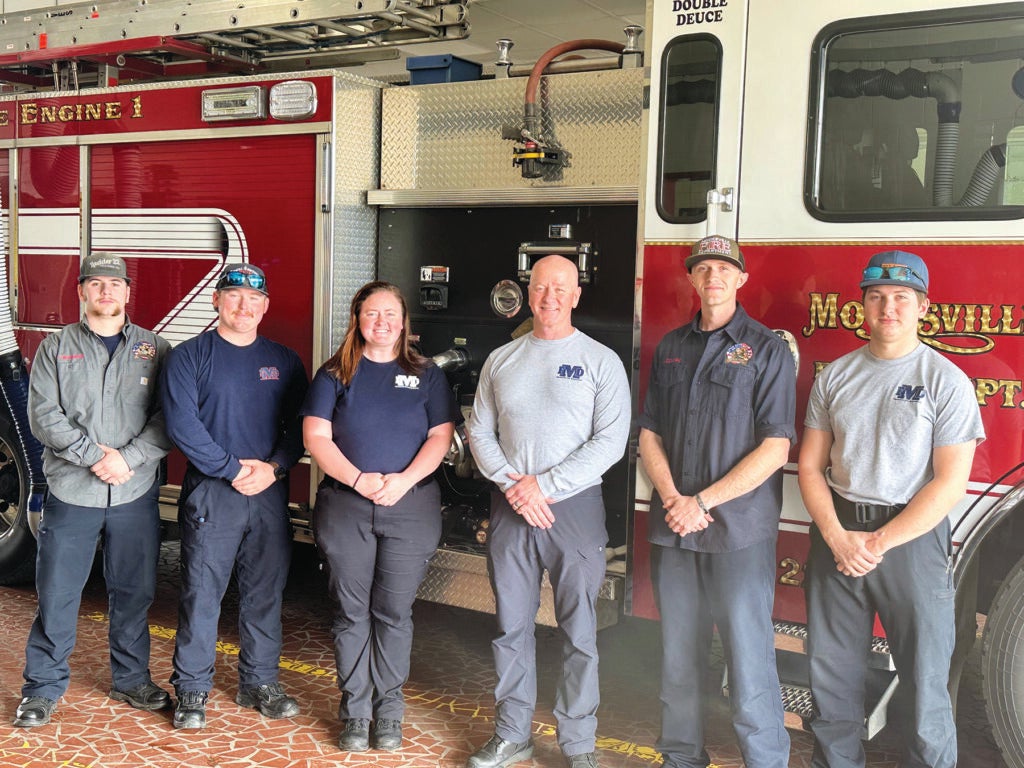Lower insurance rates? Thank you, Mocksville Fire Department
Published 1:49 pm Tuesday, March 12, 2024

- Firefighter/EMT Johnathon Bowman, Firefighter/EMT Bryson Collins, Firefighter/EMT Taylor Mohat, Chief Frank Carter, Lt. Josh Collins and Firefighter Michael Galliher at the Mocksville Fire Department.
|
Getting your Trinity Audio player ready...
|
By Jeanna Baxter White
Word Master Media Group
Mocksville residents and business owners may see a decrease in insurance costs thanks to the Mocksville Fire Department’s new ISO rating of 3.
Insurance companies often use ISO (Insurance Services Office) Fire Service Ratings to help set home insurance rates, as a home that is less likely to be severely damaged or destroyed by fire is cheaper to insure.
Mocksville Fire Chief Frank Carter received a letter from State Fire Marshal Brian Taylor last week announcing that Mocksville’s November routine inspection earned a rating of ISO Class 3 within the town limits and the surrounding area. The new score will go into effect on June 1.
“The residents of the Mocksville Fire District can take comfort in knowing this highly capable team of firefighters from the Mocksville Fire Department is safeguarding them and their belongings in the event of an emergency,” Taylor said.
The department’s previous ISO rating was 4 inside the town limits and 9 in the surrounding area. Only 189 out of 1,513 fire districts in North Carolina are rated a Class 3.
“This is a huge accomplishment for our department,” said Carter. “My go-to hashtag is ‘constant improvement,’and we continue to improve. I’m very thankful to the men and women of this department who made this achievement possible; it is a total team effort. I also appreciate Town Manager Ken Gamble and the town board for supporting us. We couldn’t have done this without their support.”
The inspection, conducted by officials with the State Fire Marshal (OSFM), is required every five years as part of the N.C. Response Rating System (NCRRS). Among other things, the routine inspections look for proper staffing levels, equipment, maintenance of equipment, communications capabilities and availability of water.
OSFM’s Public Protection Classification (PPC) program evaluates communities per a uniform set of criteria, incorporating nationally recognized standards. The rating system ranges from one (highest) to 10 (not recognized as a certified fire department by the state), with most rural departments falling into the 9S category. A community’s grade depends on:
• needed fire flows, which are representative building locations used to determine the theoretical amount of water necessary for fire suppression purposes;
• emergency communications, including emergency reporting, telecommunicators, anddispatching systems;
• fire department, including equipment, staffing, training, the geographic distribution of fire companies, operational considerations, and community risk reduction.;
• water supply, including inspection and flow testing of hydrants, alternative water supply operations, and a careful evaluation of available water compared with the amount needed to suppress fires up to 3,500 GPM;
• community risk reduction, community efforts to reduce the risk of fire, including fire prevention codes and enforcement, public fire safety education, and fire investigation programs.
Fifty percent of a community’s overall score is based upon the department’s structure fire suppression system.
OSFM’s field representative evaluated: engine and ladder/service vehicles, including reserve apparatus, equipment, response to reported structure fires, deployment analysis of companies, available and/or responding firefighters, and training.
According to Carter, the primary factor in the higher score was the addition of six full-time staff 18 months ago.
While he is grateful for the department’s volunteer and part-time staff, the rating system gives a department higher credit for career firefighters than volunteers. For ISO purposes, it takes three volunteers to equal one career firefighter since the ability to report to a fire can be inconsistent.
He said the department has applied for a federal SAFER Grant (Staffing for Adequate Fire and Emergency Response) to hire six additional full-time firefighters. If awarded the grant, each of the three shifts would be staffed with four career firefighters on duty 24/7.
“Our part-time staff will remain an integral part of our staffing model, which is to have 6-7 firefighters on duty daily,” he said.
Carter said every MFD member has completed 100 percent of ISO-required training hours. The department also received full credit for its public fire safety education efforts.
“This year, we reached 6,700 people through our fire education and risk reduction programs, which was big for us.”
“I am proud of the efforts of Chief Carter and all of his staff in achieving this for the community,” said Mocksville Town Manager Ken Gamble. “The Mocksville Fire Department continues to excel and improve the safety of everyone who lives, works, and plays in our town and the larger Mocksville Fire District.”



